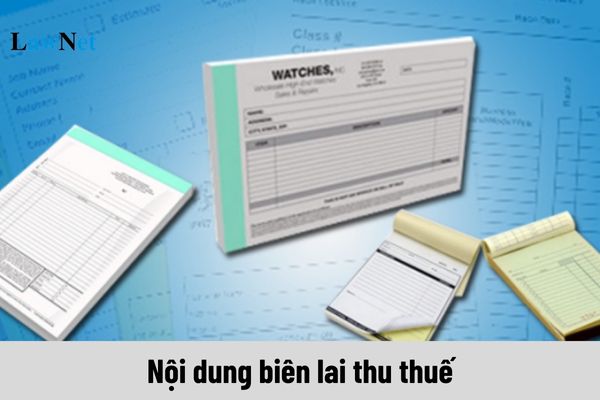Vietnam: What does the content of tax receipts include?
Vietnam: How many types of receipts are there?
Based on Article 30 of Decree 123/2020/ND-CP, the following is provided:
Type of records
1. records in the field of tax, fee, and charge management by the tax authorities include:
a) Personal income tax withholding records;
b) Receipts include:
b.1) Receipts for tax, fees, and charges without a pre-printed denomination;
b.2) Receipts for tax, fees, and charges with a pre-printed denomination;
b.3) Receipts for tax, fees, and charges.
2. During the process of managing taxes, fees, and charges following the provisions of the Tax Management Law, in cases where other types of records are required, the Minister of Finance is responsible for regulating and guiding their implementation.
Thus, the receipts include:
- Receipts for tax, fees, and charges without a pre-printed denomination;
- Receipts for tax, fees, and charges with a pre-printed denomination;
- Receipts for tax, fees, and charges.

Vietnam: What does the content of tax receipts include? (Image from the Internet)
Vietnam: What does the content of tax receipts include?
The content of tax receipts is regulated in clause 2, Article 32 of Decree 123/2020/ND-CP as follows:
- Type of receipt: Receipts for tax, fees, and charges without a pre-printed denomination; receipts for tax, fees, and charges with a pre-printed denomination; receipts for tax, fees, and charges.
- Receipt form code and receipt symbol.
+ The receipt form code indicates the type of receipt, the number of copies of the receipt, and the sequential number of the model within a type of receipt (a type of receipt can have multiple models).
+ The receipt symbol is the identification mark of the receipt using the system of Vietnamese letters and the last 02 digits of the year.
+ For printed receipts, the last 02 digits of the year are the year the receipt is printed. For self-printed receipts and e-receipts, the last 02 digits of the year are the year the receipt is first used, as indicated on the issuance notice or the year the receipt is printed out.
- The receipt number is the serial number on the receipt for tax, fees, and charges. The receipt number is written in Arabic numerals with a maximum of 7 digits. For self-printed and printed receipts, the receipt number starts from 0000001. For e-receipts, the e-receipt number starts from number 1 on January 1 or the date when the e-receipt is first used and ends on December 31 of each year.
- The copies of the receipt (applies to self-printed and printed receipts) are the number of sheets within the same receipt number. Each receipt number must have at least two copies or parts, wherein:
+ Copy (part) 1: retained by the collecting organization;
+ Copy (part) 2: given to the payer of tax, fees, charges;
In cases where there are third or more copies, they are named according to the specific usage to serve management work as prescribed by law.
- Name, tax code of the organization collecting tax, fees, charges.
- Names of types of tax, fees, charges to be collected and the amount written in numbers and words.
- Date, month, year when the receipt is made.
- Signature of the person collecting the money. In cases of using e-receipts, the signature on an e-receipt is a digital signature.
- Name, tax code of the organization receiving to print the receipt (in the case of ordering printing).
- The receipt is presented in Vietnamese. In cases where a foreign language needs to be added, the additional part in a foreign language is placed on the right within parentheses “( )” or located immediately below the content line written in Vietnamese with a smaller font size than the Vietnamese text.
Note:
- The numbers written on the receipt are natural numbers 0, 1, 2, 3, 4, 5, 6, 7, 8, 9.
- The currency recorded on the receipt is Vietnamese currency. In cases where other amounts to be collected under the state budget are legally required in foreign currency, they can be collected in foreign currency or in Vietnamese currency on the basis of conversion from foreign currency to Vietnamese currency with the exchange rate as prescribed by the law.
- In cases when collecting fees and charges, if the list of fees and charges exceeds the number of lines on a single receipt, a list can be created along with the receipt. The list is self-designed by the fee and charge collecting organization suitable to the characteristics of each type of fee or charge. The list must clearly state “attached to receipt number... dated... month.... year”.
- For organizations collecting fees and charges using e-receipts which need to adjust some contents of the e-receipt to suit reality, the organization must consult with the Ministry of Finance (General Department of Taxation) for review and guidance before implementation.
- In addition to the mandatory information mentioned above, fee and charge collecting organizations may create additional information, including logos, decorative images, or advertisements in accordance with legal regulations and without obscuring or fading the mandatory content displayed on the receipt.
- The font size of the additional information cannot be larger than the font size of the mandatory content displayed on the receipt.
What is the format of e-tax receipts in Vietnam?
The format of e-tax receipts is regulated in clause 1, Article 33 of Decree 123/2020/ND-CP as follows:
- The e-receipt format uses XML record format language (XML is an abbreviation for the English phrase "eXtensible Markup Language" created for the purpose of sharing e-data between information technology systems);
- The e-receipt format consists of two components: a component containing business data of the e-receipt and a component containing digital signature data;
- The General Department of Taxation constructs and announces the component containing business data of the e-receipt, the component containing digital signature data, and provides tools to display the contents of the e-receipt as stipulated in this Decree.

